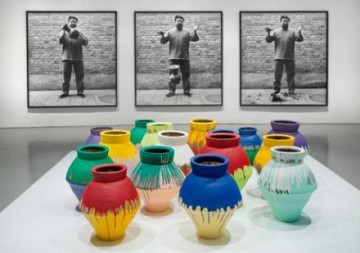
Originally published in the Marina Times San Francisco in December 2012
“Liberty is about our rights to question everything.” — Ai Weiwei
In early 2011, the artist Ai Weiwei was arrested at an airport in Beijing. He was held for months by the Chinese government, though no official charges were filed. Questions arose. What, in the 21st century, could an artist do to pose such a threat to a nation?
Currently, Ai Weiwei is having his first major U.S. installation, According to What?, at the Smithsonian’s Hirshhorn Museum and Sculpture Gardens. The title is a reference to the Jasper Johns 1971 painting, one that is considered to be Johns’ most challenging in terms of meaning. The metaphor fits for Ai Weiwei, whose conceptual art and multifaceted approach to object, craft and meaning has created admiration and sometimes hostility. Paradoxically, the artist uses history to create a way of seeing the present rather than stockpiling artifacts that serve as a monument to the past.
Weiwei’s idiosyncratic output is composed of sculpture, photography, film, architecture, glasswork, ceramics, performance art, and messages via the Internet’s multifaceted social media tools. For example, Dropping a Han Dynasty Urn from 1995 is a series of photos showing the artist dropping and shattering the ancient vessels on a sidewalk. Power through loss, or undermining the original intent of an object, becomes a message not only of shock but also of tradition’s metamorphosis into the values of a new era. Remembrance 2010 is a voice recording listing the names of over 5,000 students who died in collapsed schoolhouses during the Sichuan earthquake. Sculptures imitating natural cycles such as phases of the moon contrast with table and chair assemblages, the individual parts taken from remnants of temples; found objects of China’s history reinvented into new narratives.
His sociopolitical art, cultural criticism and human rights activism has made Ai Weiwei a natural target for Chinese authorities that try to censor his output. Far from discouraging his voice, Weiwei continually transforms his activism and adversity into more art. Brain Inflation from 2009 is a color print MRI image of the artist’s brain showing a hemorrhage suffered as the result of a police beating at a hotel in Chengdu, Sichuan province. Political struggle emerges as an aesthetic essential to his artistry. For Ai Weiwei, art is an opportunity to deconstruct society’s assumptions of value, mass production, information, and its impact on the human race. But, it’s not enough to present new possibilities for self-awareness. Weiwei encourages us all to “… do one small thing every day to prove the existence of justice.”
According to What? Hirshhorn Museum & Sculpture Garden, Smith-sonian Institution, 700 Independence Avenue SW, Washington, D.C., 202-633-4674; through Feb. 24, 2013.